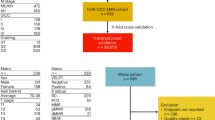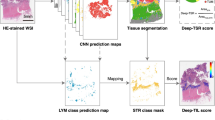Abstract
Background
The Crohn’s-like lymphoid reaction (CLR) is manifested as peritumoral lymphocytes aggregation in colon cancer, which is a major component of the host immune response to cancer. However, the lack of a unified and objective CLR evaluation standard limits its clinical application. We, therefore, developed a deep learning model for the fully automated CLR density quantification on routine hematoxylin and eosin (HE)-stained whole-slide images (WSIs) and further investigated its prognostic validity for patient stratification.
Methods
The CLR density was calculated by using a deep learning method on HE-stained WSIs. A training (N = 279) and a validation (N = 194) cohorts were used to evaluate the prognostic value of CLR density for overall survival (OS).
Result
The fully automated quantified CLR density was an independent prognostic factor, with high CLR density associated with increased OS in the discovery (HR 0.58, 95% CI 0.38–0.89, P = 0.012) and validation cohort (0.45, 0.23–0.88, 0.020). Integrating CLR density into a Cox model with other risk factors showed improved prognostic capability.
Conclusion
We developed a new immune indicator (CLR density) quantified by a deep learning method to evaluate the lymphocytes aggregation in colon cancer. The CLR density was demonstrated its predictive value for OS in two independent cohorts. This approach allows for the objective and standardized quantification while reducing pathologists’ workload. Therefore, this fully automated standardized method of CLR evaluation had potential clinical value.




Similar content being viewed by others
References
Xia L, Oyang L, Lin J, Tan S, Han Y, Wu N et al (2021) The cancer metabolic reprogramming and immune response. Mol Cancer 20:28. https://doi.org/10.1186/s12943-021-01316-8
Dieu-Nosjean MC, Giraldo NA, Kaplon H, Germain C, Fridman WH, Sautès-Fridman C (2016) Tertiary lymphoid structures, drivers of the anti-tumor responses in human cancers. Immunol Rev 271:260–275. https://doi.org/10.1111/imr.12405
Ueno H, Hashiguchi Y, Shimazaki H, Shinto E, Kajiwara Y, Nakanishi K et al (2013) Objective criteria for crohn-like lymphoid reaction in colorectal cancer. Am J Clin Pathol 139:434–441. https://doi.org/10.1309/AJCPWHUEFTGBWKE4
Dieu-Nosjean MC, Antoine M, Danel C, Heudes D, Wislez M, Poulot V et al (2008) Long-term survival for patients with non-small-cell lung cancer with intratumoral lymphoid structures. J Clin Oncol 26:4410–4417. https://doi.org/10.1200/JCO.2007.15.0284
Ishigami E, Sakakibara M, Sakakibara J, Masuda T, Fujimoto H, Hayama S et al (2019) Coexistence of regulatory B cells and regulatory T cells in tumor-infiltrating lymphocyte aggregates is a prognostic factor in patients with breast cancer. Breast Cancer-tokyo 26:180–189. https://doi.org/10.1007/s12282-018-0910-4
Maoz A, Dennis M, Greenson JK (2019) The crohn’s-like lymphoid reaction to colorectal cancer-tertiary lymphoid structures with immunologic and potentially therapeutic relevance in colorectal cancer. Front Immunol 10:1884. https://doi.org/10.3389/fimmu.2019.01884
Graham DM, Appelman HD. Crohn’s-like lymphoid reaction and colorectal carcinoma: a potential histologic prognosticator. Mod Pathol (1990) 3:332–35. https://pubmed.ncbi.nlm.nih.gov/2362940
Väyrynen JP, Sajanti SA, Klintrup K, Mäkelä J, Herzig KH, Karttunen TJ et al (2014) Characteristics and significance of colorectal cancer associated lymphoid reaction. Int J Cancer 134:2126–2135. https://doi.org/10.1002/ijc.28533
Ogino S, Nosho K, Irahara N, Meyerhardt JA, Baba Y, Shima K et al (2009) Lymphocytic reaction to colorectal cancer is associated with longer survival, independent of lymph node count, microsatellite instability, and CpG island methylator phenotype. Clin Cancer Res 15:6412–6420. https://doi.org/10.1158/1078-0432.CCR-09-1438
Kim JH, Kim KJ, Bae JM, Rhee YY, Cho NY, Lee HS et al (2015) Comparative validation of assessment criteria for Crohn-like lymphoid reaction in colorectal carcinoma. J Clin Pathol 68:22–28. https://doi.org/10.1136/jclinpath-2014-202603
Lewis B, Lin J, Wu X, Xie H, Shen B, Lai K et al (2013) Crohn’s disease-like reaction predicts favorable prognosis in colitis-associated colorectal cancer. Inflamm Bowel Dis 19:2190–2198. https://doi.org/10.1097/MIB.0b013e31829e13e1
Murphy J, O’Sullivan GC, Lee G, Madden M, Shanahan F, Collins JK et al (2000) The inflammatory response within Dukes’ B colorectal cancers: implications for progression of micrometastases and patient survival. Am J Gastroenterol 95:3607–3614. https://doi.org/10.1111/j.1572-0241.2000.03377.x
Hynes SO, Coleman HG, Kelly PJ, Irwin S, O’Neill RF, Gray RT et al (2017) Back to the future: routine morphological assessment of the tumour microenvironment is prognostic in stage II/III colon cancer in a large population-based study. Histopathology 71:12–26. https://doi.org/10.1111/his.13181
Konishi T, Shimada Y, Lee LH, Cavalcanti MS, Hsu M, Smith JJ et al (2018) Poorly differentiated clusters predict colon cancer recurrence: an in-depth comparative analysis of invasive-front prognostic markers. Am J Surg Pathol 42:705–714. https://doi.org/10.1097/PAS.0000000000001059
Stower H (2019) Machines match humans in image-based diagnoses. Nat Med 25:1798. https://doi.org/10.1038/s41591-019-0679-9
Hu Y, Su F, Dong K, Wang X, Zhao X, Jiang Y et al (2021) Deep learning system for lymph node quantification and metastatic cancer identification from whole-slide pathology images. GASTRIC CANCER [Online ahead of print]. doi: https://doi.org/10.1007/s10120-021-01158-9
Yamashita R, Long J, Longacre T, Peng L, Berry G, Martin B et al (2021) Deep learning model for the prediction of microsatellite instability in colorectal cancer: a diagnostic study. Lancet Oncol 22:132–141. https://doi.org/10.1016/S1470-2045(20)30535-0
Kather JN, Krisam J, Charoentong P, Luedde T, Herpel E, Weis CA et al (2019) Predicting survival from colorectal cancer histology slides using deep learning: a retrospective multicenter study. Plos Med 16:e1002730. https://doi.org/10.1371/journal.pmed.1002730
Zhao K, Li Z, Yao S, Wang Y, Wu X, Xu Z et al (2020) Artificial intelligence quantified tumour-stroma ratio is an independent predictor for overall survival in resectable colorectal cancer. EBioMedicine 61:103054. https://doi.org/10.1016/j.ebiom.2020.103054
Zhou Y, Xu X, Song L, Wang C, Gou J, Yi Z et al (2020) The application of artificial intelligence and radiomics in lung cancer. Precis Clin Med 3:214–227. https://doi.org/10.1093/pcmedi/pbaa028
Rozek LS, Schmit SL, Greenson JK, Tomsho LP, Rennert HS, Rennert G et al (2016) Tumor-infiltrating lymphocytes, crohn’s-like lymphoid reaction, and survival from colorectal cancer. J Natl Cancer Inst. https://doi.org/10.1093/jnci/djw027
Toh J, Lim SH, MacKenzie S, de Souza P, Bokey L, Chapuis P et al (2020) Association between microsatellite instability status and peri-operative release of circulating tumour cells in colorectal cancer. Cells-Basel 9:425. https://doi.org/10.3390/cells9020425
Greenson JK, Bonner JD, Ben-Yzhak O, Cohen HI, Miselevich I, Resnick MB et al (2003) Phenotype of microsatellite unstable colorectal carcinomas: well-differentiated and focally mucinous tumors and the absence of dirty necrosis correlate with microsatellite instability. Am J Surg Pathol 27:563–570. https://doi.org/10.1097/00000478-200305000-00001
Greenson JK, Huang SC, Herron C, Moreno V, Bonner JD, Tomsho LP et al (2009) Pathologic predictors of microsatellite instability in colorectal cancer. Am J Surg Pathol 33:126–133. https://doi.org/10.1097/PAS.0b013e31817ec2b1
Jenkins MA, Hayashi S, O’Shea AM, Burgart LJ, Smyrk TC, Shimizu D et al (2007) Pathology features in Bethesda guidelines predict colorectal cancer microsatellite instability: a population-based study. Gastroenterology 133:48–56. https://doi.org/10.1053/j.gastro.2007.04.044
Overman MJ, McDermott R, Leach JL, Lonardi S, Lenz HJ, Morse MA et al (2017) Nivolumab in patients with metastatic DNA mismatch repair-deficient or microsatellite instability-high colorectal cancer (CheckMate 142): an open-label, multicentre, phase 2 study. LANCET ONCOL 18:1182–1191. https://doi.org/10.1016/S1470-2045(17)30422-9
Yeh YC, Nitadori J, Kadota K, Yoshizawa A, Rekhtman N, Moreira AL et al (2015) Using frozen section to identify histological patterns in stage I lung adenocarcinoma of ≤ 3 cm: accuracy and interobserver agreement. Histopathology 66:922–938. https://doi.org/10.1111/his.12468
Steu S, Baucamp M, von Dach G, Bawohl M, Dettwiler S, Storz M et al (2008) A procedure for tissue freezing and processing applicable to both intra-operative frozen section diagnosis and tissue banking in surgical pathology. VIRCHOWS ARCH 452:305–312. https://doi.org/10.1007/s00428-008-0584-y
Hildebrand LA, Pierce CJ, Dennis M, Paracha M, Maoz A (2021) Artificial intelligence for histology-based detection of microsatellite instability and prediction of response to immunotherapy in colorectal cancer. Cancers (Basel) 13:391. https://doi.org/10.3390/cancers13030391
Hansen TF, Kjær-Frifeldt S, Lindebjerg J, Rafaelsen SR, Jensen LH, Jakobsen A et al (2018) Tumor-stroma ratio predicts recurrence in patients with colon cancer treated with neoadjuvant chemotherapy. ACTA ONCOL 57:528–533. https://doi.org/10.1080/0284186X.2017.1385841
van Pelt GW, Sandberg TP, Morreau H, Gelderblom H, van Krieken J, Tollenaar R et al (2018) The tumour-stroma ratio in colon cancer: the biological role and its prognostic impact. Histopathology 73:197–206. https://doi.org/10.1111/his.13489
Park JH, Richards CH, McMillan DC, Horgan PG, Roxburgh C (2014) The relationship between tumour stroma percentage, the tumour microenvironment and survival in patients with primary operable colorectal cancer. ANN ONCOL 25:644–651. https://doi.org/10.1093/annonc/mdt593
Ueno H, Jones AM, Wilkinson KH, Jass JR, Talbot IC (2004) Histological categorisation of fibrotic cancer stroma in advanced rectal cancer. Gut 53:581–586. https://doi.org/10.1136/gut.2003.028365
Galon J, Costes A, Sanchez-Cabo F, Kirilovsky A, Mlecnik B, Lagorce-Pagès C et al (2006) Type, density, and location of immune cells within human colorectal tumors predict clinical outcome. Science 313:1960–1964. https://doi.org/10.1126/science.1129139
Pagès F, Mlecnik B, Marliot F, Bindea G, Ou FS, Bifulco C et al (2018) International validation of the consensus Immunoscore for the classification of colon cancer: a prognostic and accuracy study. Lancet 391:2128–2139. https://doi.org/10.1016/S0140-6736(18)30789-X
Acknowledgements
This work was supported by the Key R&D Program of Guangdong Province, China [2021B0101420006], National Science Fund for Distinguished Young Scholars [81925023], National Natural Science Foundation of China [82001986, 62002082 and 82071892], Outstanding Youth Science Foundation of Yunnan Basic Research Project [202101AW070001], Project funded by China Postdoctoral Science Foundation [2021M690753], and High-level Hospital Construction Project [DFJH201805 and DFJH201914].
Funding
Funding sources can be found in the acknowledgements section.
Author information
Authors and Affiliations
Contributions
Study design: MNZ, SY, and ZYL. Performed the research and collected data: MNZ, SY, ZHL, LW, ZYX, XPP, HL, YX, SQY, and SYZ. Analyzed the data: KZ and MNZ. Manuscript drafting: MNZ and KZ. Labeled images: SY and LW. Provided discussion, critical feedback and manuscript editing: ZYL, CHL, KZ, and YS.
Corresponding authors
Ethics declarations
Conflict of interest
The authors declared no conflicts of interest.
Data Sharing
The data sets for training the model was available online (https://doi.org/10.5281/zenodo.4024676, https://doi.org/10.5281/zenodo.4023999).
Additional information
Publisher's Note
Springer Nature remains neutral with regard to jurisdictional claims in published maps and institutional affiliations.
Précis: We developed a new immune indicator (CLR density) quantified by a deep learning method to evaluate the lymphocytes aggregation in colon cancer, and demonstrated its predictive value for OS. This automated approach has the value of clinical work.
Supplementary Information
Below is the link to the electronic supplementary material.
Rights and permissions
About this article
Cite this article
Zhao, M., Yao, S., Li, Z. et al. The Crohn’s-like lymphoid reaction density: a new artificial intelligence quantified prognostic immune index in colon cancer. Cancer Immunol Immunother 71, 1221–1231 (2022). https://doi.org/10.1007/s00262-021-03079-z
Received:
Accepted:
Published:
Issue Date:
DOI: https://doi.org/10.1007/s00262-021-03079-z




